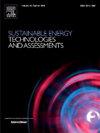A comprehensive process modelling, techno-economic and life cycle assessment of a power to ammonia process
IF 7.1
2区 工程技术
Q1 ENERGY & FUELS
Sustainable Energy Technologies and Assessments
Pub Date : 2025-03-22
DOI:10.1016/j.seta.2025.104278
引用次数: 0
Abstract
Ammonia is currently produced through H2 derived from fossil sources and hereby alternative low carbon ammonia routes are essential for mitigating emissions. The present study for the first time investigates the feasibility of the whole supply chain of a Power-to-Ammonia (PtA) assembly though comprehensive process design and modelling, techno-economic assessment (TEA) and life cycle assessment (LCA). The investigated system includes offshore electricity generation, hydrogen produced through water electrolysis, nitrogen production through cryogenic air separation unit (ASU), and the Haber–Bosch (H-B) ammonia synthesis loop. The Aspen Plus software has been utilised to establish the mass and energy balances of the synthesis while System Model Advisor (SAM) software has been used to model the offshore wind farm. The H2 conversion efficiency (H2-conv.), the ammonia energy efficiency (NH3-efficiency) and the specific energy consumption (SEC) have been considered as technical key indicators. Typical economic indicators such as Capital and Operating expenditures (CAPEX/OPEX) and minimum selling price (MSP) of ammonia have been calculated while the CML 2001 environmental impact assessment method has been applied for the whole assembly. Moreover, a sensitivity analysis is carried out to assess the influence of the main parameters on both TEA/LCA. The results showed an H2-conv and NH3-efficiency of 96 % and 49 %, respectively. Energy integration resulted in a power generation of 14.3 MW. The economic analysis revealed a levelized cost of ammonia (LCOA) of £687/tonne NH3 which is higher than the fossil based-ammonia price of £245/tonne. However, the economic sensitivity analysis shows that a 50 % reduction in the levelized cost of electricity (i.e., £33MWh) could decrease the LCOA to £361/tonne of ammonia while to break even with the fossil ammonia price an LCOE of £21/MWh is required. Based on the LCA, the global warming potential (GWP) of the PtA is reduced by approximately 94 % compared to the conventional fossil-based ammonia (152 vs 2445 kg CO2e/tonne NH3). Further reduction on GWP can be achieved by replacing offshore wind with nuclear power supply.
Overall, the investigated PtA assembly offer great environmental gains, but monetary support and/or technical improvements are required to improve its market competitiveness. The study presented new data on a novel low carbon ammonia process and the information generated can set the foundation for detailed engineering designs and inform policy making.
综合过程建模,技术经济和生命周期评估的一个电力制氨过程
目前,氨是通过来自化石资源的氢气生产的,因此替代低碳氨途径对于减少排放至关重要。本研究通过综合工艺设计和建模、技术经济评估(TEA)和生命周期评估(LCA),首次探讨了动力制氨(PtA)装配整个供应链的可行性。所研究的系统包括海上发电,通过水电解制氢,通过低温空气分离装置(ASU)制氮,以及Haber-Bosch (H-B)氨合成回路。Aspen Plus软件已被用于建立综合的质量和能量平衡,而系统模型顾问(SAM)软件已被用于模拟海上风电场。将氢气转化效率(H2-conv.)、氨能效率(NH3-efficiency)和比能耗(SEC)作为技术关键指标。在采用CML 2001环境影响评价方法对整个装置进行评价的同时,计算了典型的经济指标,如资本和运营支出(CAPEX/OPEX)和氨的最低销售价格(MSP)。此外,还进行了敏感性分析,以评估主要参数对TEA/LCA的影响。结果表明,h2 -转化率为96%,nh3效率为49%。能源整合产生了14.3兆瓦的发电量。经济分析显示,氨的平准化成本(LCOA)为每吨NH3 687英镑,高于每吨245英镑的化石基氨价格。然而,经济敏感性分析表明,将电力平准化成本(即33MWh英镑)降低50%,可将LCOA降至361英镑/吨氨,而要与化石氨价格持平,LCOE需要达到21英镑/兆瓦时。基于LCA,与传统的化石基氨相比,PtA的全球变暖潜能值(GWP)降低了约94%(152对2445千克CO2e/吨NH3)。进一步降低全球变暖潜能值可以通过用核能取代海上风电来实现。总的来说,所调查的PtA组件提供了巨大的环境收益,但需要资金支持和/或技术改进以提高其市场竞争力。该研究为一种新型低碳氨工艺提供了新的数据,所产生的信息可以为详细的工程设计奠定基础,并为政策制定提供信息。
本文章由计算机程序翻译,如有差异,请以英文原文为准。
求助全文
约1分钟内获得全文
求助全文
来源期刊

Sustainable Energy Technologies and Assessments
Energy-Renewable Energy, Sustainability and the Environment
CiteScore
12.70
自引率
12.50%
发文量
1091
期刊介绍:
Encouraging a transition to a sustainable energy future is imperative for our world. Technologies that enable this shift in various sectors like transportation, heating, and power systems are of utmost importance. Sustainable Energy Technologies and Assessments welcomes papers focusing on a range of aspects and levels of technological advancements in energy generation and utilization. The aim is to reduce the negative environmental impact associated with energy production and consumption, spanning from laboratory experiments to real-world applications in the commercial sector.
 求助内容:
求助内容: 应助结果提醒方式:
应助结果提醒方式:


